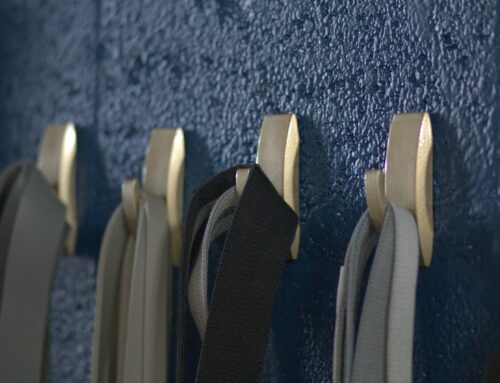

Introduction to the Triceps Muscle
The triceps brachii, commonly referred to as the triceps, is a crucial muscle located at the back of the upper arm. Understanding the anatomy and functioning of the triceps is integral for anyone aiming to enhance their upper body strength. The triceps brachii comprises three distinct heads: the long head, the lateral head, and the medial head, each originating from different locations but converging into a common insertion point. These three heads work in harmony to facilitate various arm and shoulder movements.
The long head of the triceps originates from the infraglenoid tubercle of the scapula. This part of the triceps not only contributes to elbow extension but also aids in arm adduction and shoulder stability. The lateral head has its origin at the posterior surface of the humerus, superior to the radial groove, while the medial head originates from the posterior surface of the humerus, inferior to the radial groove. Both the lateral and medial heads primarily contribute to the extension of the elbow.
All three heads insert at the olecranon process of the ulna, forming a distinctive horseshoe shape when developed. The primary function of the triceps is elbow extension, which is essential in many daily activities and athletic movements. Additionally, the triceps assist in arm adduction and play a role in stabilizing the shoulder joint, underscoring their vital role in maintaining upper body strength and mobility.
For individuals looking to improve their upper body strength, understanding the anatomy and functionality of the triceps muscle is paramount. This knowledge not only aids in the effective targeting of the triceps during workouts but also helps in preventing injuries by ensuring exercises are performed with proper form. The triceps muscle, with its integral role in various movements and stability mechanisms, is indeed a cornerstone of upper body strength training.
Functional Roles of the Triceps in Upper Body Movement
The triceps brachii, commonly referred to as the triceps, play a crucial role in upper body strength and movement. As a primary muscle group located at the back of the upper arm, the triceps are integral to various pushing and pressing exercises. For instance, during push-ups, bench presses, and overhead presses, the triceps are actively engaged to extend the elbows and facilitate arm movement.
These exercises emphasize the triceps’ role in producing force for forward and upward motions, which are essential for athletic performance and daily tasks. For example, in a bench press, the triceps help in the latter phase of pushing the weight upwards, ensuring the arms reach full extension. Similarly, in an overhead press, strong triceps contribute to lifting the weight above the head, showcasing their importance in vertical pressing actions.
Beyond isolated movements, the triceps are vital in compound exercises that utilize multiple muscle groups. For instance, in exercises like dips or close-grip bench presses, the triceps work synergistically with the chest and shoulder muscles to produce powerful, coordinated movements. This synergy underscores the triceps’ role in enhancing overall upper body power and functional capabilities.
The triceps also play a significant role in stabilizing the elbow and shoulder joints. During various physical activities, such as lifting, pushing, or throwing, the triceps help maintain joint integrity by providing necessary support and control. This stabilization function is essential in preventing injuries and promoting efficient movement patterns.
Furthermore, strong triceps can significantly enhance athletic performance and everyday activities that require upper body strength. Whether it’s pushing a heavy door, lifting grocery bags, or engaging in sports that involve upper body actions like swimming or boxing, well-developed triceps ensure that these tasks are executed with ease and power.
In conclusion, the functional contributions of the triceps extend beyond mere aesthetics; they are indispensable for upper body mechanics, stability, and performance. Understanding and strengthening this muscle group can lead to improved physical capabilities and overall well-being.
Building Triceps Strength: Exercises and Techniques
Enhancing triceps strength is crucial for improving upper body power and overall muscle balance. A variety of exercises are essential to develop the entire triceps muscle group, which consists of three heads: the long head, lateral head, and medial head. Key exercises such as tricep dips, skull crushers, triceps pushdowns, and close-grip bench presses can effectively target the triceps when performed with the correct techniques.
Tricep dips are a fundamental exercise that primarily engages the triceps but also activates the chest and shoulders. To perform tricep dips safely, use parallel bars or a sturdy bench. Lower your body by bending your elbows until your upper arms are parallel to the ground, then push upwards to return to the starting position. Ensure your elbows are tucked close to your body to maximize tricep engagement and minimize shoulder strain.
Skull crushers, also known as lying tricep extensions, are excellent for isolating the triceps. Lie on a bench and hold a barbell or dumbbells with a close grip. Lower the weights towards your forehead or just behind your head while keeping your upper arms stationary. Extend your arms back to the starting position, fully contracting the triceps at the top. This exercise emphasizes the long head of the triceps and requires controlled movement to avoid injuries.
Triceps pushdowns, typically done using a cable machine, are effective for honing the lateral and medial heads of the triceps. Attach a straight or angled bar to the high pulley. Start with your elbows bent at a 90-degree angle, and push the bar down until your arms are fully extended. Keep your elbows close to your sides and avoid using body momentum to ensure the triceps bear the workload.
The close-grip bench press involves pressing a barbell with a narrow grip, which shifts emphasis from the chest to the triceps. Lie on a flat bench, grip the bar with hands about shoulder-width apart, and lower it to your chest. Press the bar back to the starting position, focusing on tricep contraction rather than chest engagement.
To maximize triceps development, it is essential to vary your exercise routines. Engaging all three heads of the triceps prevents muscle imbalances and avoids plateaus. Progressive overload, or gradually increasing the weight and intensity of your exercises, is vital for continuous muscle growth and strength gains. Additionally, adequate rest and recovery periods are necessary to allow the triceps to repair and grow stronger.
Common Mistakes and Injury Prevention
When training the triceps, individuals often fall into several common pitfalls that can impede their progress and increase the risk of injury. One prevalent mistake is improper form. Performing exercises with incorrect technique not only reduces the effectiveness of the workout but also places unnecessary stress on the joints and tendons. For example, failing to keep the elbows tucked in during triceps extensions can lead to undue strain on the shoulder joint.
Overtraining is another significant issue. The triceps are engaged in virtually any upper body pressing movement, so it’s easy to overwork them without realizing it. Exceeding the optimal training volume can result in overuse injuries, such as tendonitis. It’s crucial to allow adequate recovery time between sessions, ensuring the muscles can repair and grow stronger.
Another frequent error is neglecting other muscle groups that support triceps function. The body operates as an interconnected system, and isolating the triceps without strengthening surrounding muscles—like the biceps, shoulders, and chest—can lead to muscle imbalances and potential injuries. An integrative training approach that emphasizes compound movements, in addition to isolation exercises, promotes overall upper body strength and stability.
Warm-ups, stretches, and cool-downs specifically targeting the triceps are essential practices for injury prevention. A thorough warm-up increases blood flow to the muscles, enhancing their flexibility and readiness for exertion. Dynamic stretches before the workout and static stretches afterward can help maintain muscle elasticity and joint health. Post-exercise cool-downs facilitate gradual recovery, reducing muscle stiffness and soreness.
Listening to one’s body is paramount to prevent overuse injuries. Pain should not be ignored, as it is the body’s signal indicating that something is wrong. Modifying workouts when discomfort arises and incorporating regular rest days into the routine can ensure long-term, sustainable gains without compromising health.
About the author : Tricep
We valued your need and thought . Main aim is to keep you fit with our suggestion and help let have a lifestyle
Latest videos
The Vital Role of Exercise in Maintaining Our Health
Understanding Exercise and Its Impact on HealthExercise is a cornerstone of a healthy lifestyle, often regarded as a vital factor in promoting overall health and well-being. Engaging in regular physical activity not only enriches the [...]
The Role of Triceps in Bench Press: Maximize Your Gains
```html Understanding the Bench Press and Its Muscle Groups The bench press is a compound exercise, revered in the strength training community for its ability to enhance upper body power and muscle development. At its [...]
Join our mailing list today
Insider offers & flash sales in your inbox every week.
Curabitur non nulla sit amet nisl tempus convallis quis ac lectus dolor sit amet, consectetur adipiscing elit sed porttitor lectus.









